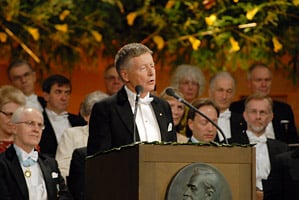Award ceremony speech
Presentation Speech by Professor Per Carlson, Member of the Royal Swedish Academy of Sciences, Chairman of the Nobel Committee in Physics, December 10, 2006.
 |
| Professor Per Carlson delivering the Presentation Speech for the 2006 Nobel Prize in Physics at the Stockholm Concert Hall. Copyright © The Nobel Foundation 2006 Photo: Hans Mehlin |
Your Majesties, Your Royal Highnesses, Laureates, Ladies and Gentlemen.
Gaze into the sky on a clear, starlit night and feel the fascination of the cosmic spectacle it offers. Fifty years ago astronomers used earth-bound telescopes to explore space. The instruments then in use enabled us to see stars and galaxies so far away that their light had taken some hundreds of millions of years to reach us. This year’s Nobel Prize in Physics is for another kind of astronomy, in which the instruments on the COBE satellite were used to observe radiation that was sent to us about 13 billion years ago, from another, much earlier era in the development of the universe.
At that time the character of the Universe had just altered. Previously it had been a dense, hot and impenetrable soup of electrons, protons and radiation. The temperature was so high and the Universe so dense that the radiation was swallowed up by the soup, just as light is veiled by fog. But the Universe is expanding, which means that its density and the temperature is sinking, and at the same time the energy of the radiation is lessening – which is the same as saying its wavelength is rising. The radiation that had previously been swallowed up by the soup was released – like when the fog lifts. The temperature had then sunk to 3,000 degrees and it is estimated that the Universe was about 380,000 years old. The released radiation could continue its long, unimpeded journey through the Universe.
During the radiation’s 13-billion-year journey the Universe has expanded mightily and its wavelength has extended one thousandfold, at the same time the temperature has dropped from 3,000 to about three degrees above absolute zero. This cold background radiation fills the Universe and is a relic from its earliest stages, but it is invisible to the eye. The extended waves can be observed in the microwave area, with wavelengths of a few millimetres. It is this original radiation that the COBE satellite observed.
John Mather was responsible for the instruments on board COBE that were able to determine with great precision the temperature of the background radiation and also confirm that this spectrum had the characteristic blackbody form, characterising the hot uniform state of the early Universe.
George Smoot was in charge of the instruments that were searching for very small variations – about one per 100,000 – in the temperature of the background radiation in various directions. These variations would provide the seeds of the structures, in the shape of stars and galaxies, that evolved from the original hot, uniform soup. After collecting data for several years, it was possible to show that the small variations sought for really existed. The first step towards understanding the development of structures in the Universe had been taken.
Dr Mather, Professor Smoot: Cosmology has become a precision science and your ground-breaking research laid the foundation for that. With your carefully calibrated instruments you have shown the cosmic microwave background radiation to follow very precisely a blackbody form. The in-depth analysis of the radiometer data has shown the presence of the long sought small temperature anisotropies, the seed of the structures in the Universe that we observe today. In your successful experiments you have used space-based instruments on board the COBE satellite. We are now all together at sea level in Stockholm, and on behalf of the Royal Swedish Academy of Sciences it is my privilege and pleasure to congratulate you for your outstanding work and I now ask you to step forward to receive your Nobel Prizes from the hands of His Majesty the King.
Nobel Prizes and laureates
Six prizes were awarded for achievements that have conferred the greatest benefit to humankind. The 14 laureates' work and discoveries range from quantum tunnelling to promoting democratic rights.
See them all presented here.
